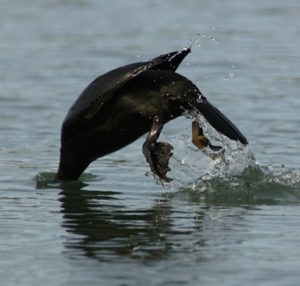Double-Crested Cormorant (Phalacrocorax auritus)
 Appearance: brown-black feathers; black, webbed feet; gray, narrow, hooked beak; orange skin on face near beak; blue eyes; long neck that kinks in flight
Appearance: brown-black feathers; black, webbed feet; gray, narrow, hooked beak; orange skin on face near beak; blue eyes; long neck that kinks in flight
Breeding adults have white or black tufty feathers on head
Males are slightly larger than females, but coloration is the same
- Height: 28-35 inches (about 2.5 feet)
- Wingspan: 45-48 inches (about 4 feet)
- Status: common, increasing
Over last thirty years, populations have made significant recovery from severe declines due to pesticide use in mid-1900s
However, they are still vulnerable to water pollutants, which accumulate in their prey
- Habitat
- Live near any freshwater/saltwater body large enough to support foraging behavior – may rest in small lagoons or ponds and fly up to 40 miles to feed
- Use nearby rocks, sandbars, pilings, shipwrecks, wires, trees or docks for resting on and drying out during the day
- Most widespread cormorant out of 6 in North America
- Utilize all areas of United States, range is seasonal and varies through the year
- Adults in Alaska are largest and have white crests, closer to southern limit of range (Bahamas) they are smaller and have black tufts
- Sometimes killed or injured when they are caught on fish hooks and in gill-nets, lobster traps, and trawls
 Diet
Diet
- Eat fish almost exclusively – known to eat over 250 varieties of fish across range
- Also eat crustaceans, insects, and amphibians, but infrequently
- Sometimes eat plant material
- May feed together in flocks if they spot school of fish
- Swim low in water, only show heads, necks, and tops of backs
- When prey is spotted, thrust themselves up on top of water’s surface, then dive into water and swim after prey
- Swallow small fish in water, but may bring larger prey to surface to smash them against water before eating them
- Usually forage in shallow water (about 10 feet deep), but one cormorant was recorded diving 150 feet to the ocean floor
- Cormorants may spend more than half of day resting and drying
- While drying, often spread their wings
- Cormorants have less preen oil than other birds, so their feathers can get soaked rather than shedding water like a duck’s
- This may actually help them to hunt in water – oil is less buoyant than water, therefore oily feathers would make it harder to dive
- Cormorants have less preen oil than other birds, so their feathers can get soaked rather than shedding water like a duck’s
- Migration
- Live on Long Island year-round, as well as much of east and west coasts of United States and on tropical islands
- Migratory populations breed in northernmost United States, Alaska, and Canada
- Spring migration occurs from March – April
- Overwintering populations migrate across continent to east and west coasts of United States and coastal Mexico- settle inland to avoid resident populations
- Arrive in wintering areas from September – October
- Tend to migrate in large groups (sometimes by the thousands)
- Unlike flocks of geese, cormorants fly silently
- Flocks may take shape of line, wedge, or sloppy V
- Cruising speed is about 15-20 mph, top speed is about 35 mph
 Nesting
Nesting
- Highly social bird (“gregarious”)- roosts and nests in colonies, sometimes mixed with other species, finds one mate per year
- During breeding season form small or large colonies with other cormorants, one colony may have thousands of birds
- Large cormorant colonies pose a risk of harming their nesting environment- accumulation of guano from large number of birds kills vegetation and can pollute soil and water
- If cormorants live in areas where nesting habitat is scarce(habitat lost), they are more likely to concentrate around one nesting site because there is no other favorable site
- Normally breed around small lagoons or ponds
- Nest on ground, on rocks or reefs with no vegetation, or atop trees (live or dead)
- Often return to the same nesting site – even if trees on site are dead and toppled, they stay and make ground nests
- Males bring female vegetation, which she weaves into a nest
- Nests usually made of small sticks, seaweed, and grass
- Cormorants may steal nesting material from unguarded nest
- Average brood is 1-7 pale blue eggs
- Immatures are brown, lightest on necks and breasts, feathers gradually fade to near-black as they mature
- Double crested cormorant mature after 3 years, average lifespan is 6-8 years, but the oldest discovered was about 22 years old
- Highly social bird (“gregarious”)- roosts and nests in colonies, sometimes mixed with other species, finds one mate per year







